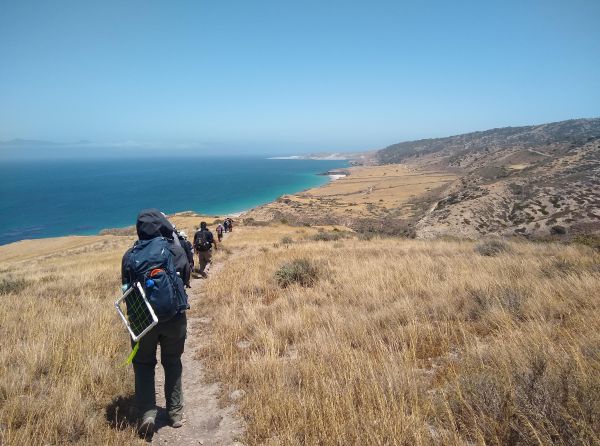Plans are underway for the launch in 2026 of “The Island Experience at CSU Channel
Islands” course following a successful experience in which 15 students from seven
different colleges and universities spent eight days and seven nights living and learning
on the trails and under the stars at CSUCI’s Santa Rosa Island Research Station (SRIRS). 
Associate Professor of Environmental Science & Resource Management Dan Reineman designed “The Island Experience” to be adapted to fit any area of the arts or sciences, with Santa Rosa Island as the classroom.
“The students remember this,” Reineman said. “The ecosystems and places themselves are way more charismatic than any classroom lecture. Being out on the island helps the students understand and appreciate the connections.”
Reineman envisions this program as a template that will enable any faculty member from any department to slot in their own summer course on the island.
“The island is the best classroom you can imagine, regardless of the discipline. Faculty from across CSUCI have an incredible track record of bringing their students to the SRIRS — everyone from Art and Dance to Anthropology and Sociology.”
The challenge, Reineman said, has always been to provide students with the opportunity for extended visits, which gives the experience more impact.
“Logistics, administration, curriculum — these all get significantly more complex for longer trips, but we think we've ironed out a framework that could be broadly adapted,” Reineman said.
The 15 students who participated in the pilot program in May 2025 came from across the region, including CSUCI, Pierce and Ventura Colleges, CSU Los Angeles, Cal Poly SLO, CSU Northridge, and CSU Long Beach. Their backgrounds were just as diverse, ranging from ESRM, Biology, History, Geology, Psychology, Bioengineering, and more.
“This breadth really showcases the broad appeal of island-based courses,” Reineman said. “And it made for a fabulous dynamic among the students’ community — so much peer-to-peer teaching and learning.”
The students received two days of preparatory study in the classroom, then traveled to the SRIRS for an island learning adventure that lasted eight days. While on the island, the students hiked, cooked, watched the stars, and visited tidepools and cloud forests — forested areas that trap fog and moisture. They also worked their way through 200 pages of reading for the course.
Reineman worked hard to pair activities and destinations on Santa Rosa Island with a variety of important elements of the islands’ natural and cultural history.
The visit to the mountaintop cloud forest—which involved a pre-dawn hike— left CSUCI students Madison Mills and Cassandra Fernandez in awe.
“We left on time—4:30 a.m.!—and enjoyed a surreal hike using the light of dawn to guide us,” Fernandez said. “A couple of hours later we arrived at the top of the mountain where we all convened to sing Bohemian Rhapsody. We then proceeded into the forest where we were transported into another world!”
Mills described how the group hiked under the canopy of oaks and were wrapped in fog.
“There, the fog condensed on all the leaves enough to make them drip. And drip they did, and a whole new world was growing under the oaks because of it,” Mills said. “The moss was thick on the tree trunks and branches, and banana slugs lay all about on the thick leaf litter, which was turning into fertile soil.”
The students agreed that some of the activities they enjoyed the most included a day spent splashing through tidepools, identifying different species, learning about the preservation of the bald eagle and island fox, and lying out on the dock at night and looking at the stars.
“Our goal was to explore all the different history and ecosystems and management—and how they are connected,” Reineman said. “We learned how profoundly humans have altered the island over the last century and a half, but also about the legacy of stewardship of the Island Chumash for millennia before that—as well as in the present day.”
Over the years, Reineman has run dozens of other island programs, as have CSUCI’s Executive Director of Regional Educational Partnerships and Professor of Anthropology, Jennifer Perry, and Director of the Santa Rosa Island Research Station, Robyn Shea. Together, they've sought to develop and refine a framework for on-island summer programs that are just the right length and also affordable and doable for both professors and students.
Reineman is currently working with colleagues at CSUCI and other universities to further develop this summer programming opportunity, which he hopes will eventually attract audiences from beyond California.
“Extended stays at remote field stations are transformational in the lives of students — they certainly were in mine,” Reineman said. “But they're largely out of reach for most students. The Santa Rosa Island Research Station is unique in the CSU and in the country, and we have the opportunity to offer programming there that is affordable and accessible to our entire student population. Our goal is to create a flagship CSUCI experience that we can offer to students nationwide.”
